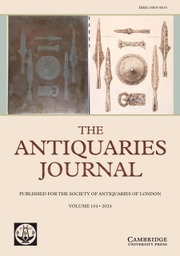Professor McClanan has gathered together examples of the usage of griffins from different cultures and different continents going back 5,000 years to ancient Egypt and ancient Mesopotamia. These are considered from an art historical perspective, presented in a very approximate chronological sequence over fifteen well illustrated chapters. Chapter 1 naturally addresses the question of definitions, and here a difficulty arises because rather a broad range of creatures is included, such as ‘griffin demons’ (Assyrian human figures with thee head and wings of birds), winged lions, ‘donkey griffins’, de facto dragons (with reference to a bronze dragon of the city of London found at Temple Bar) and the modern hippogriff (horse-eagle). This provides a rather broader base for discussion than might otherwise have been the case. A variety overlooked in this assemblage of non-canonical griffins is the Dacian wolf-griffin, which makes an appearance on the spectacular hexagonal bronze mould from Sarmizegetusa Regia.
The Egyptian usage was minor, and served largely as an alter ego of the pharaoh, likely in his capacity as a solar deity. The evidence of Herodotus, who described the griffin as a guardian of gold from the eastern regions, suggests that it came to the Greek world from western Asia. As flying creatures, griffins were well suited to providing air transportation for the gods, in particular for the sun god Apollo whose chariot they pulled (providing the same service for Dionysus/Bacchus), while as animals of singular viciousness who would readily tear a man to shreds, they were appropriated as companions for the goddess Nemesis. The griffin is noted to have a strong association with death, with frequent usage on Roman sarcophagi.
Moving into the Christian era, the powerful strength possessed by the griffin enabled it to travel to the heavens, and this made it a suitable emblem for the Byzantine imperial household, with various examples given, including a depiction of the Emperor Alexios v Doukas, who was deposed by the western knights of the Fourth Crusade in ad 1204. He wears silks charged with the griffin. Griffin textiles, both Byzantine and Islamic, are known from at least the beginning of the ninth century, from which western European samples have survived because they were used to wrap the bones of saints. Griffins are among the many animals that border the Bayeux tapestry, where one of them heralds the death of Edward the Confessor.
A recurring theme is a rising popularity of the griffin in western Europe from the twelfth century onwards in the aftermath of the First Crusade of ad 1099, and the author considers that the crusading movement played an important role in this dissemination. Examples cited include the use of griffins as guardians outside the doors of Italian and Aquitanian churches, and the late incorporation of the monster into the Latin version of the Physiologus (from which derived the medieval bestiaries) in twelfth-century England. The griffin had long been present in the eastern Greek language Physiologus. The griffin was strongly associated in the western European mind with the Holy Land, it being given to inhabit the landscape of that region in the history of the Crusades written by Fulcher of Chartres (d after ad 1127) who resided in Jerusalem. Moreover, a life of St Imerius of Switzerland, which was copied c ad 1200, described how this saint had overcome a ferocious griffin in the Holy Land and taken its claw as a trophy. Such claws featured in a medieval inventory of Durham cathedral.
Heraldic aspects are covered briefly in Chapter 13, which notes a number of interesting instances. These include the strange wingless ‘male griffin’, which was granted as a supporter to Queen Anne Boleyn, from whose torso menacing spikes project; the griffin privy seal of Edward iii taken from the livery badge of the king’s friend William Montagu, Earl of Salisbury; and medieval English lead griffin badges, which might have been granted as livery by either Edward iii or Salisbury, or might simply have had some apotropaic function.
The book is brought up to date with no less than eight pages devoted to Harry Potter, the second lengthiest and most detailed part of the book after an earlier chapter on the griffin in the tattoos of nomadic central Asia. The Potter section was presumably included to enhance marketability. Most readers with an interest in griffins will find something to interest them in one or more of the short chapters, but the reviewer was compelled to return to John Cherry’s account of the griffin in his book Mythical Beasts (1995) to find a clear and succinct historical overview with which to usefully compare McClanan’s book. This earlier source mentions an important piece of information surprisingly absent here, which is that griffins are mentioned in the Bible, notably in the Book of Deuteronomy in which Moses forbids the tribes of Israel from eating griffins.
Despite a lack of clarity and a somewhat chaotic style of presentation, McClanan covers the subject with a considerable breadth that serves to whet the appetite for further enquiry.


